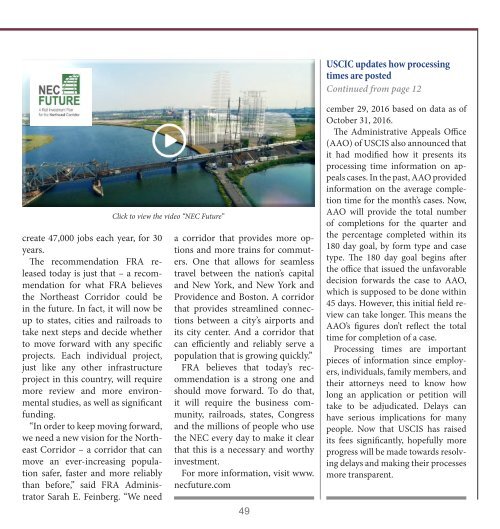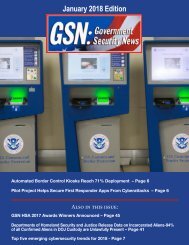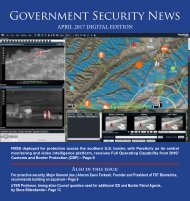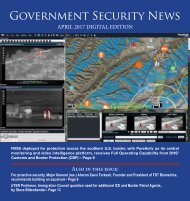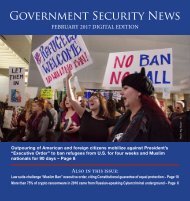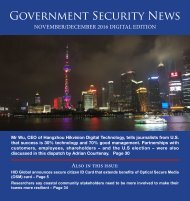Government Security News January 2017 Digital Edition
Government Security News January 2017 Digital Edition. Available on the GSN Magazine Website at www.gsnmagazine.com
Government Security News January 2017 Digital Edition. Available on the GSN Magazine Website at www.gsnmagazine.com
You also want an ePaper? Increase the reach of your titles
YUMPU automatically turns print PDFs into web optimized ePapers that Google loves.
USCIC updates how processing<br />
times are posted<br />
Continued from page 12<br />
create 47,000 jobs each year, for 30<br />
years.<br />
The recommendation FRA released<br />
today is just that – a recommendation<br />
for what FRA believes<br />
the Northeast Corridor could be<br />
in the future. In fact, it will now be<br />
up to states, cities and railroads to<br />
take next steps and decide whether<br />
to move forward with any specific<br />
projects. Each individual project,<br />
just like any other infrastructure<br />
project in this country, will require<br />
more review and more environmental<br />
studies, as well as significant<br />
funding.<br />
“In order to keep moving forward,<br />
we need a new vision for the Northeast<br />
Corridor – a corridor that can<br />
move an ever-increasing population<br />
safer, faster and more reliably<br />
than before,” said FRA Administrator<br />
Sarah E. Feinberg. “We need<br />
Click to view the video “NEC Future”<br />
a corridor that provides more options<br />
and more trains for commuters.<br />
One that allows for seamless<br />
travel between the nation’s capital<br />
and New York, and New York and<br />
Providence and Boston. A corridor<br />
that provides streamlined connections<br />
between a city’s airports and<br />
its city center. And a corridor that<br />
can efficiently and reliably serve a<br />
population that is growing quickly.”<br />
FRA believes that today’s recommendation<br />
is a strong one and<br />
should move forward. To do that,<br />
it will require the business community,<br />
railroads, states, Congress<br />
and the millions of people who use<br />
the NEC every day to make it clear<br />
that this is a necessary and worthy<br />
investment.<br />
For more information, visit www.<br />
necfuture.com<br />
49<br />
cember 29, 2016 based on data as of<br />
October 31, 2016.<br />
The Administrative Appeals Office<br />
(AAO) of USCIS also announced that<br />
it had modified how it presents its<br />
processing time information on appeals<br />
cases. In the past, AAO provided<br />
information on the average completion<br />
time for the month’s cases. Now,<br />
AAO will provide the total number<br />
of completions for the quarter and<br />
the percentage completed within its<br />
180 day goal, by form type and case<br />
type. The 180 day goal begins after<br />
the office that issued the unfavorable<br />
decision forwards the case to AAO,<br />
which is supposed to be done within<br />
45 days. However, this initial field review<br />
can take longer. This means the<br />
AAO’s figures don’t reflect the total<br />
time for completion of a case.<br />
Processing times are important<br />
pieces of information since employers,<br />
individuals, family members, and<br />
their attorneys need to know how<br />
long an application or petition will<br />
take to be adjudicated. Delays can<br />
have serious implications for many<br />
people. Now that USCIS has raised<br />
its fees significantly, hopefully more<br />
progress will be made towards resolving<br />
delays and making their processes<br />
more transparent.


